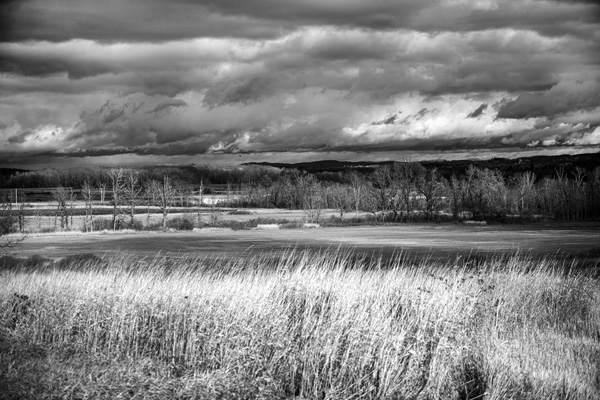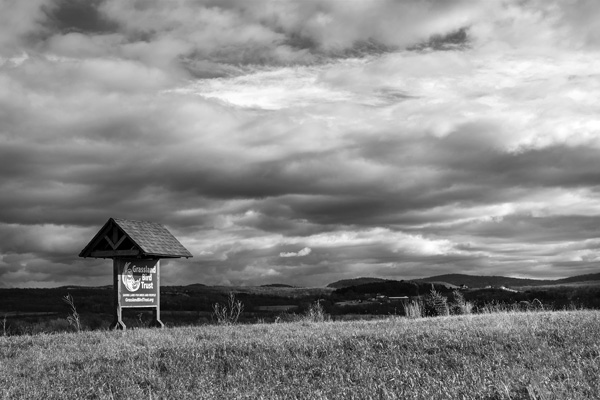News & Issues December 2022/ January 2023
Endangered owls, meet solar panels
Green goals collide as energy firm plans project in prime bird habitat

The vast expanse of open land known as the Washington County grasslands is home to 10 of the 11 grassland bird species that are considered in greatest need of conservation in New York. photo by Joan K. Lentini
By TRACY FRISCH
Contributing writer
FORT EDWARD, N.Y.
For the past dozen years, local conservationists have been working to preserve hundreds of acres of critical bird habitat in the area known as the Washington County grasslands.
Members and supporters of the Grassland Bird Trust have forged ties with local private landowners as well as local and state officials to protect the area’s open fields, which are home to 10 of the 11 grassland bird species that are considered in greatest need of conservation in New York. Among these are short-eared owls, which once were common in New York but now are classified as endangered.
But lately the group has been grappling with a new challenge to its efforts: a developer’s proposal for a large-scale solar energy installation covering up to 800 acres within the 2,000-acre grassland zone that the National Audubon Society has designated as an “important bird area.”
Boralex, a Montreal-based renewable energy company, has obtained lease options on 2,000 acres from private landowners in the area and says it intends to place solar panels on at least 700 acres. The 100-megawatt project is expected to be operational by 2024.
“We support renewable energy,” said Katherine Roome, the board secretary of the Grassland Bird Trust. “But they have chosen an extremely sensitive area that has been recognized as an important bird area.”

The Grassland Bird Trust has been working for the past 12 years to conserve critical bird habitat in the Washington County grasslands, and the group established the Alfred Z. Solomon Grassland Viewing Area, above, where the public can see some of the dozens of bird species, some rare, that breed, winter or migrate through the area. Now the group is seeking to mitigate the effects of an 800-acre solar power installation proposed for the area. Joan K. Lentini photo
Leaders of the Grassland Bird Trust have engaged actively with Boralex since they first learned of the company’s planned solar project in early 2019, Roome said.
Boralex has sought the group’s advice in identifying quality habitat areas it might set aside to mitigate the project’s effects, and Grassland Bird Trust board members have met with the company’s representatives on multiple occasions.
“We have been telling Boralex that we want to have the most conservation acres built into the project as possible -- more than the bare minimum has been our consistent message,” said Ron Renoni, an advisory board member and past president of the bird trust.
After almost four years of talks, however, the bird trust’s board members say they remain in the dark about how the company intends to protect important habitat and mitigate habitat losses resulting from the solar project.
And under a new regulatory system the state adopted in 2020 to speed the development of renewable energy projects, the developer’s legal obligations to protect wildlife habitat have been greatly reduced.
New York’s old power plant siting law, which previously covered such projects, set a formula for mitigating habitat taken for an energy generation project. It required 3 acres to be conserved for every acre of grassland bird habitat taken by the project.
But under the new law, a solar developer only has to conserve 0.2 acres for winter habitat and 0.4 acres for breeding habitat for each acre of land taken for a solar installation. The new law pertains to all projects over 25 megawatts.
The push for renewable energy
New York’s new system for regulating renewable energy projects -- which remains the subject of a pending court challenge by a coalition of rural towns, conservation and advocacy groups -- was adopted by the Legislature in 2020 as part of that year’s state budget deal with the administration of then-Gov. Andrew Cuomo.
Its purpose was to speed up development of large-scale projects that would help the state meets its ambitious goals for renewable energy production. The state aims to draw 70 percent of its energy from renewable sources by 2030.
Shifting from fossil fuels to renewable energy sources has been a key goal of environmental groups that are concerned about mitigating the effects of climate change, and the state’s focus on renewables has continued under Gov. Kathy Hochul.
In early June, Hochul announced awards for 22 large-scale solar and energy storage projects “that will deliver enough clean, affordable energy to power over 620,000 New York homes for at least 20 years.” Among the projects selected was Boralex’s proposed 100-megawatt solar facility in the towns of Fort Edward and Argyle.
The state also selected four other Boralex projects, totaling 440 megawatts, to be sited in northern New York, the Mohawk Valley and the greater Capital Region, including a 20-megawatt solar project in the town of Easton.
These projects appear to be Boralex’s first solar installations in New York, although the company owns a small hydroelectric plant in Greenwich.
“Cuomo and Hochul have made renewable energy a very high priority,” Roome said.
But she and others say the need for renewable energy production needs to be balanced against other environmental considerations.
Roome noted that a couple of years ago, another solar developer, CS Solar, opted not to pursue a solar project in Fort Edward to avoid the grasslands bird area. That company is currently building a large solar project along Route 40 in Easton in the southern part of the county.
But she said Boralex is interested in Fort Edward because of its proximity to a transmission line – and because the land is relatively inexpensive and wouldn’t need to be cleared.
A rare expanse of open fields
The Washington County grasslands stretches across a vast, relatively flat valley of fields, meadows and wetlands along the western side of the county. The area encompasses about 13,000 acres in total, with striking views of the hills that roll away toward the Green Mountains in the east and the Adirondacks to the north. More than 100 different bird species breed, winter or migrate through this area.
The area is the largest contiguous grasslands complex in New York state east of the Hudson River. It provides critical habitat to songbirds like bobolinks, bluebirds and meadowlarks as well as to threatened and endangered raptors such as the northern harrier and the short-eared owl.
Audubon designated a 2,000-acre portion of the grasslands in Fort Edward, Argyle and Kingsbury as an “important bird area,” or IBA, in 1997.
And in 2010, an organization called Friends of the IBA, which later became the Grassland Bird Trust, was formed to educate the public and advocate for imperiled grassland bird species and their disappearing habitat. The group raised awareness through a series of public programs, including a Winter Raptor Fest at which people could view the owls, harriers, hawks and falcons that spend their winters hunting in the grasslands.

The Fort Edward grasslands is considered vital to the survival of the endangered short-eared owl in New York. Although the owls were once common in the state, only 50 to 100 breeding pairs remain. Courtesy photo/Gordon Ellmers
The state Department of Environmental Conservation subsequently acquired 478 acres from a number of private landowners and created the Washington County Grasslands Wildlife Management Area. This area has three stated purposes: wildlife management, wildlife habitat management, and wildlife-dependent recreation such as bird watching and photography.
The Grassland Bird Trust owns conservation easements on 78 acres, which it manages for grassland bird habitat. Another 42-acre conservation easement of grassland habitat is located adjacent to the bird trust’s easement, provided by a different solar energy company to mitigate the impacts of its 70-acre installation.
When the DEC began acquiring land for the Wildlife Management Area in 2014, local municipal officials expressed their worries about taking land off the tax rolls. The Grassland Bird Trust raised the issue with area legislators.
“We had Assembly member Carrie Woerner and state Sen. Betty Little introduce legislation in their respective houses,” Renoni recalled. “It took three years to pass both houses and was signed into law in August 2018. It required DEC to pay the property taxes on the grassland wildlife management area land that it purchases in the towns of Fort Edward, Argyle and Kingsbury due to their depressed economic profiles. They argued that it was only fair to have the state contribute to the tax base as it does for the forever wild lands.”
The resolution of the property tax issue eliminated a source of tension with the town of Fort Edward and fostered greater support for the group’s efforts to protect critical bird habitat.
Disappearing grassland birds
Although a series studies have documented an overall decline in bird populations in recent decades, the statistics for grassland birds show a particularly rapid decline. A 2019 study published in the journal Science found that North America has lost 25 percent of its birds since 1970, with grassland birds experiencing a steeper decline of 50 percent in that period. That amounts to a loss of 700 million grassland birds in 50 years.
Grassland birds also are reproducing far less well than in the past. In New York, the DEC has reported a drop of 80 percent to 99 percent in grassland bird species breeding pairs over the last four decades. The agency attributes this decline to habitat loss and degradation.
A 2,000-acre core area of the Fort Edward Grasslands IBA is considered critical to the survival of short-eared owls in New York. Short-eared owls used to be the most common owl species in the state, outnumbering all other owls in lowlands and marshy areas. But today only 50 to 100 breeding pairs remain. According to the most recently published Breeding Bird Atlas, dated 2005 (the atlases only come out every 20 years), the remaining pairs of short-eared owls only breed within 12 square miles in the entire state.
Renoni said most biologists believe the short-eared owls decline results mainly from the loss of large, intact grasslands and other open habitats because of changing land-use patterns. Once agricultural fields are abandoned, they rapidly become unsuitable for these owls because the fields revert to forest or are replaced by development.
“The DEC biologist told us that the bigger the reserve, the more likely you’ll get short-eared owls and harrier hawks to nest,” Renoni said.
The Fort Edward bird area now offers “thousands of acres of potential habitat,” Renoni said. Much of this open land can function as winter habitat for raptors when hay farms “go silent” after the growing season ends, he said. In the winter, raptors migrate from the north, seeking grasslands where they can hunt small rodents, such as voles.
Birds among the solar panels
There has been little academic research into the effects of solar farms on grassland birds. Keith Swenson, president of the Grassland Bird Trust, said he’s not aware of any pertinent studies involving the grassland species of the Northeast.
What is known, however, is that raptors such as the short-eared owl and northern harrier fly close to the ground while seeking their prey. New York lists these birds respectively as endangered and threatened. An industrial-scale solar project would not be compatible with their hunting behavior.
In the Boralex project, solar panels would be installed high above the ground on posts. An aisle nearly 30 feet wide would be placed between rows to maximize the efficiency of the solar panels. (The spacing prevents one row of panels from shading the next.)
Officials of the bird trust say some smaller birds, such as sparrows, finches and other songbirds, will probably be able to live, breed and feed under and around photovoltaic panels. But these are not the threatened or endangered birds the trust is trying to protect.
The Fort Edward area has become prime habitat for grassland birds because its poorly drained, clay soils prevent the growing of corn and other row crops, leaving hayfields as the prevalent agricultural enterprise.
Because most grassland birds build their nests on the ground in the late spring, however, successful breeding is incompatible with the standard haying schedule, which involves a first cutting in late May or June. Survival of fledglings requires this initial mowing to be much delayed.
Swenson said that his organization is working with the American Bird Trust and National Audubon Society to find a way to protect important bird habitat from Boralex’s solar project.
New rules and a legal challenge
The Legislature created the state Office of Renewable Energy Siting in 2020 when it passed the Accelerated Renewable Energy Growth and Community Benefit Act as part of the annual state budget. The purpose of the law – and the new agency -- is to fast-track the siting of industrial-scale wind and solar energy projects. This in turn will help the state to meet its goal of producing a much larger share of its energy from renewable sources.
But this approach has drawn opposition. In June 2021, a coalition of towns, community organizations and bird advocacy groups challenged the Office of Renewable Energy Siting in court, arguing that the new agency’s regulations fail to comply with the State Environmental Quality Review Act. The longstanding environmental law requires “all state and local government agencies to consider environmental impacts equally with social and economic factors” when taking government action.
Ben Wisniewski, the main lawyer representing the plaintiffs in the case, is also representing rural towns, civic groups and conservation organizations in individual cases in which fast-tracked renewable energy projects threaten vulnerable bird species or disregard community character concerns and municipal land use rules.
“My complaints have to do with the process,” Wisniewski said.
The court challenge was brought by a coalition of six rural upstate towns, including the Columbia County town of Copake, as well as community organizations and bird groups including the American Bird Conservancy, Delaware-Otsego Audubon Society, Genesee Valley Audubon Society and Rochester Birding Association.
The plaintiffs don’t aim to prevent solar or wind energy projects. Rather, they seek to require the state’s renewable energy office to adopt new regulations that would minimize the impacts of large-scale energy projects on biodiversity and rural upstate communities’ land use regulations.
A state Supreme Court justice in Albany County ruled against the plaintiffs in September 2021, but an appeal is pending.
“I think as a legal matter our appellate case is quite strong,” said William Sheehan, the general counsel and vice president of the American Bird Conservancy.
He noted that the renewable energy office has not yet responded to the appellate brief. The agency’s response was originally due in July, Sheehan said, but it has asked for, and been granted, at least three extensions.
Ignoring risks to wildlife?
Under the regulations the groups are seeking to overturn, each application for a large renewable energy project must be deemed complete within 60 days after submission, and each project must be approved within a year.
These new regulations establish uniform conditions for all such projects, without regard to a municipality’s existing land use rules or the existence of sensitive ecosystems or at-risk wildlife. In fact, the new renewable energy siting law supersedes all municipal laws and regulations. The Office of Renewable Energy Siting has the authority to waive a local law if it “unduly burdens the environmental benefits of a renewable energy project.”
In their court challenge, opponents contend the inflexible timelines enshrined in the regulations will not always be sufficient for appropriate wildlife field studies to be conducted. But if deadlines are not met, the regulations require that projects receive automatic approval by default.
The plaintiffs argue that the new regulations do nothing to ensure that projects are sited in locations that minimize risks to vulnerable wildlife. For example, the Heritage Wind project in Orleans County is proposed adjacent to a high-biodiversity wetland complex that supports nesting bald eagles and many rare species and is a stop on a major migratory pathway for birds.
“I think we’re in a climate where the deck is completely stacked in favor of renewable energy.” Sheehan said, though he stressed that “we’re not opposed to renewable energy.”
Rather, he said, his organization objects to projects proposed for inappropriate sites.
“In the U.S., there are 1,500 wind projects,” Sheehan said. “The American Bird Conservancy has opposed about five of them because they were badly sited and would be perilous to migratory birds.”
Audubon predicts that two-thirds of bird species will face extinction because of climate change, and bird advocates say they understand the need to move away from the burning of fossil fuels. But they also say biodiversity and ecosystem health shouldn’t need to be sacrificed for the expansion of renewable energy.
